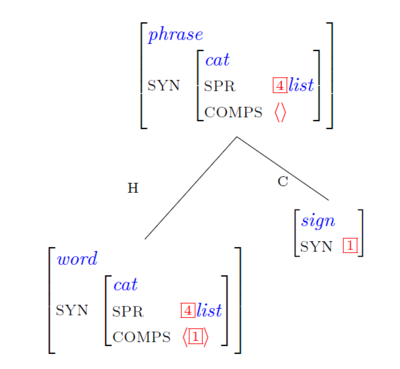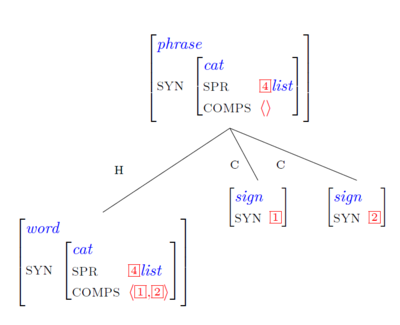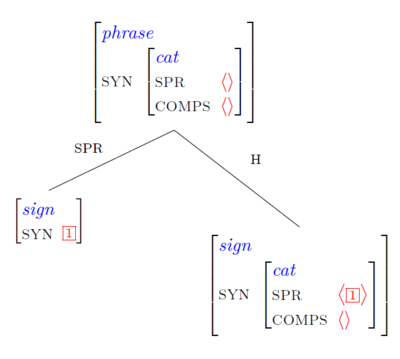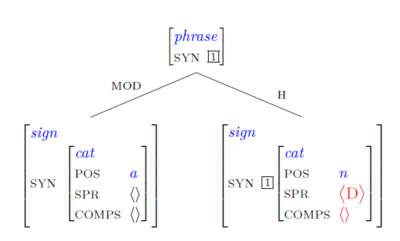Syntax 1 Wiki: Week 6
Types of Phrases
Head-Complement Phrases
A head-complement phrase can be formed by combining a word [= the head daughter] with 1 or 2 signs [= the non-head daughter(s)] whose syntactic categories can be unified with the syntactic categories on the word’s comps list.
Schema 1: The head licenses 1 complement
This schema licenses the following structure:
XP -> X + COMPS
Examples:
- [PP [H of][C Lilly]]
- [AP [H fond][C of Lilly]]
- [VP [H likes][C Fido]]
- [VP [H speaks][C to Fido]]
Schema 2: The head licenses 2 complements
This schema licenses the following structure:
XP -> X + COMPS
Examples:
- [VP [H show][C me][C Frankfurt]]
- [VP [H give][C the book][C to the student]]
- [VP [H put][C the book][C on the table]]
Head-Specifier Phrases
A head-specifier phrase can be formed by combining a sign [= the head daughter] with a second sign [= the non-head daughter] whose syntactic category can be unified with the syntactic category on the word’s spr list:
This schema licenses the following structures:
- NP -> D NP
- [NP [SPR the][H student]]
- [NP [SPR those][H apples]]
- S -> NP VP
- [S [SPR Lilly][H smokes]]
- [S [SPR Lilly][H likes Fido]]
- [S [SPR The student][H showed a cat to Fido]]
Head-Modifier Phrases
There are 3 kinds of head-modifier phrases.
a. A Head-modifier phrase can be formed by combining an adjectival sign [= the non-head
daughter] with a nominal sign [= the head daughter] which is COMPS-complete but is sill looking
for its specifier.
This schema licenses the following structure:
- NP -> A N(P)
- [NP [MOD happy][H student]]
- [NP [MOD big][H cat]]
- [NP [MOD huge][H interest in languages]]
b. A Head-modifier phrase can be formed by combining a PP [= the non-head daughter]
with a nominal sign [= the head daughter] which is COMPS-complete but is sill looking for its specifier:
Phrase Formation
Here is the file that we went through in class this week:
File:Phrase-Formation-Version3.pdf
Navigation:



